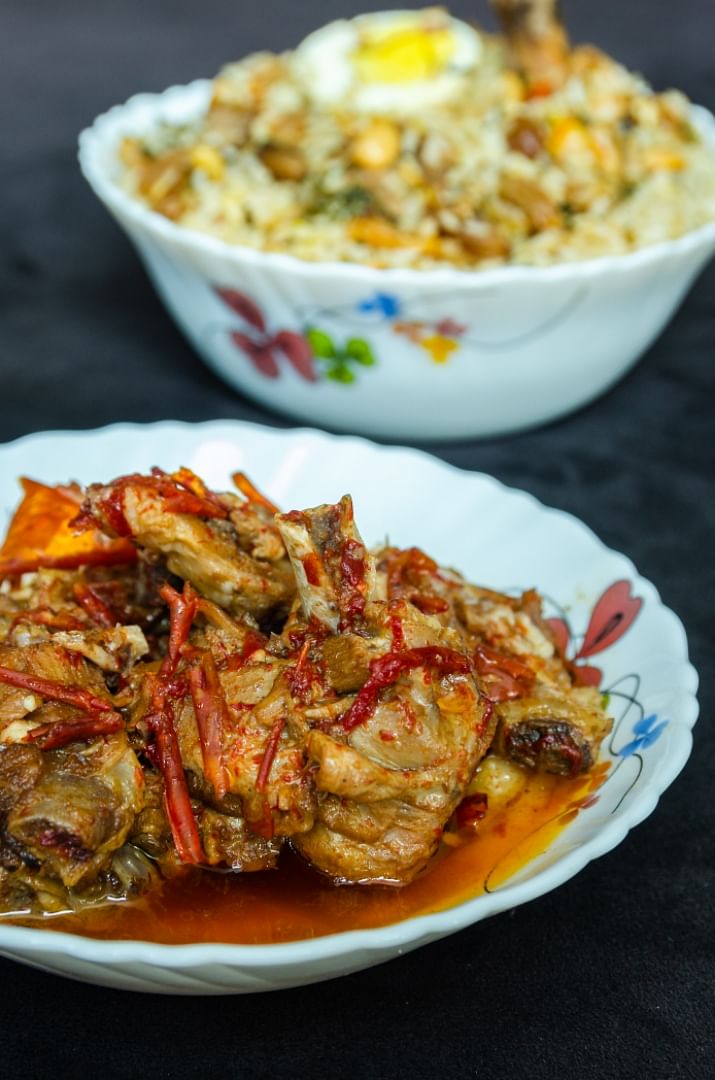Rajani Sen Road, does that ring a bell? It’s the famous neighbourhood of the fictitious Bengali investigator Feluda, created by the master storyteller Satyajit Ray. The same Rajani Sen Road is now the house of some of the best coastal cuisines in Kolkata along with some other regional delicacies with the addition of Surfiré – The Coastal Café.
In Kolkata, ask anyone about their biryani they will go weak in the knees with the imagination of fluffy, long-grained and flavourful rice, tender meat, juicy potato and the heady aroma of Kolkata Biryani. Few will also know about Hyderabadi Biryani but very less will be aware of other variants.
Ishani Priyadarshini, chef and owner of Surfiré introduces to the citizens of Kolkata the Thalassery Chicken Biryani. Originated from once a strategic port town Thalassery in Kerala, the briyani has influence of Malabari, Arabs and Mughals.
The chicken and rice are cooked separately with Malabar spices. An indigenous variety of short-grained rice called Kaima or Jeera-kasala is used for its characteristic aroma. Cooked rice and the chicken are placed in layers, topped with fried cashew nuts, sultanas, birista and slow-cooked using dum pukht technique. A true Thalassery Biriyani is something to live for!
From the down under if we little up towards the central part of India, we come across a festive preparation called Haleem. It is a popular delicacy of Hyderabadi cuisine and has its origins in the Middle East. Traditionally a Ramadan special delicacy served as an evening meal during iftar after fasting for the whole day.
Surfiré prepares Mutton Haleem in the most authentic way to give it a mushy texture. The slow-cooked delicacy is a bowl full of protein and flavour. The mash of minced mutton, lentils, spices, broken wheat and a melange of spices. To amp up the flavour sprinkle sweet caramelised barista and squeeze a dash of lemon on the top. Those who love it a bit more spicy, finely diced green chillies shall tickle your taste buds.
Have you ever thought of preparing mutton gravy with only three ingredients? Moving towards the northern part of India, in the prehistoric days Rajasthani royals set out for their annual months-long hunting. The hunting company would typically carry bare minimal practical ingredients clarified butter(ghee), salt and dried Mathenia chillies which would be used to cook the game meat in the jungle. To camouflage the gamy odour of the meat a lot of chillis are used. That’s how this dish got its name Junglee Maas (transl. wild meat).
Back in Kolkata now, that authenticity in the preparation of Junglee Maas can be witnessed inside the kitchen of Surfiré. Mutton is slow-cooked for hours in low flame in its own juices until the meat falls off from the bone. One cardinal rule for cooking this dish – mutton is always prepared in ghee with dried Mathenia chillies. The layer of floating ghee on the top of the Junglee Maas makes it irresistible.
In Kolkata, ask anyone about their biryani they will go weak in the knees with the imagination of fluffy, long-grained and flavourful rice, tender meat, juicy potato and the heady aroma of Kolkata Biryani. Few will also know about Hyderabadi Biryani but very less will be aware of other variants.
Ishani Priyadarshini, chef and owner of Surfiré introduces to the citizens of Kolkata the Thalassery Chicken Biryani. Originated from once a strategic port town Thalassery in Kerala, the briyani has influence of Malabari, Arabs and Mughals.
The chicken and rice are cooked separately with Malabar spices. An indigenous variety of short-grained rice called Kaima or Jeera-kasala is used for its characteristic aroma. Cooked rice and the chicken are placed in layers, topped with fried cashew nuts, sultanas, birista and slow-cooked using dum pukht technique. A true Thalassery Biriyani is something to live for!
From the down under if we little up towards the central part of India, we come across a festive preparation called Haleem. It is a popular delicacy of Hyderabadi cuisine and has its origins in the Middle East. Traditionally a Ramadan special delicacy served as an evening meal during iftar after fasting for the whole day.
Surfiré prepares Mutton Haleem in the most authentic way to give it a mushy texture. The slow-cooked delicacy is a bowl full of protein and flavour. The mash of minced mutton, lentils, spices, broken wheat and a melange of spices. To amp up the flavour sprinkle sweet caramelised barista and squeeze a dash of lemon on the top. Those who love it a bit more spicy, finely diced green chillies shall tickle your taste buds.
Have you ever thought of preparing mutton gravy with only three ingredients? Moving towards the northern part of India, in the prehistoric days Rajasthani royals set out for their annual months-long hunting. The hunting company would typically carry bare minimal practical ingredients clarified butter(ghee), salt and dried Mathenia chillies which would be used to cook the game meat in the jungle. To camouflage the gamy odour of the meat a lot of chillis are used. That’s how this dish got its name Junglee Maas (transl. wild meat).
Back in Kolkata now, that authenticity in the preparation of Junglee Maas can be witnessed inside the kitchen of Surfiré. Mutton is slow-cooked for hours in low flame in its own juices until the meat falls off from the bone. One cardinal rule for cooking this dish – mutton is always prepared in ghee with dried Mathenia chillies. The layer of floating ghee on the top of the Junglee Maas makes it irresistible.

